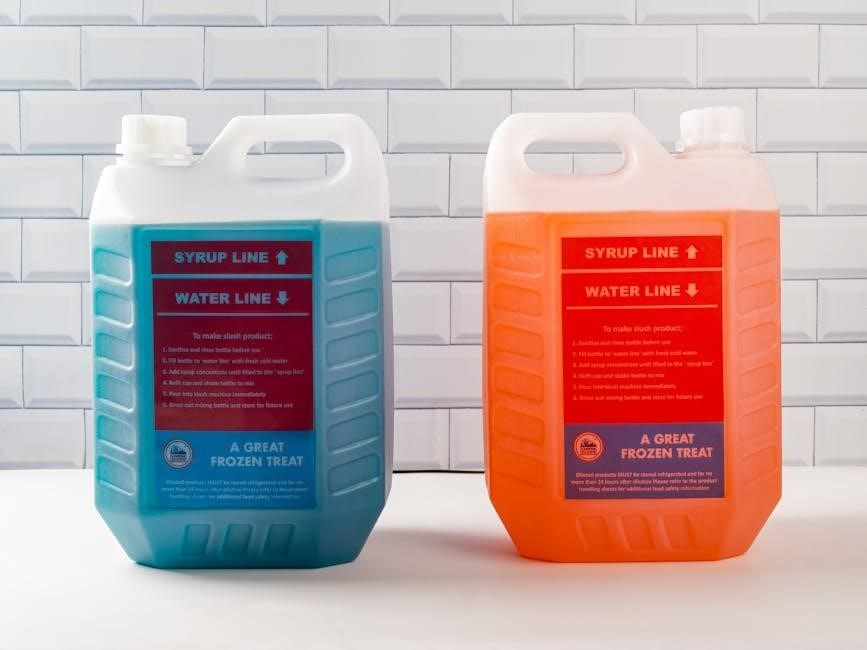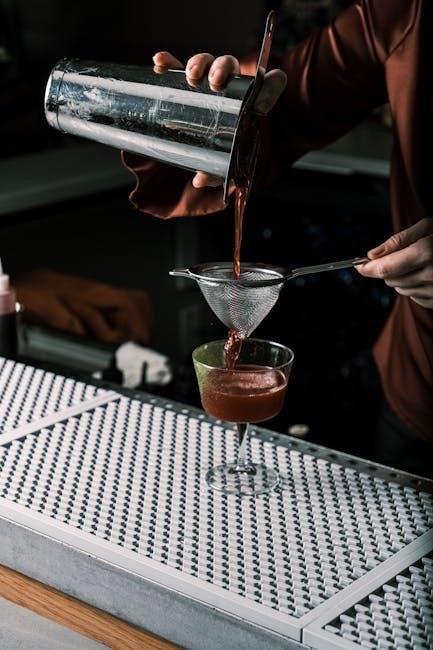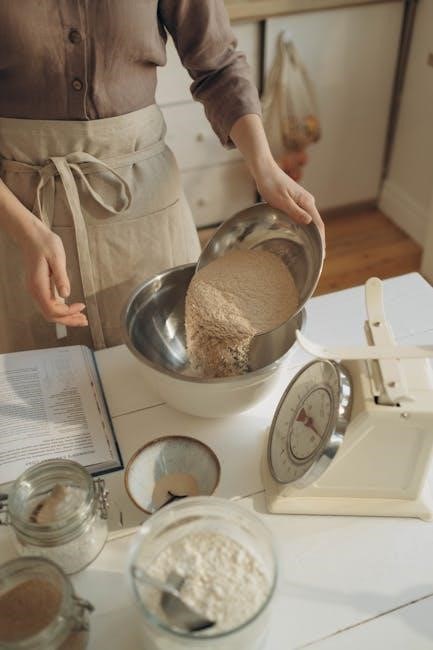Martins Permethrin 13.3 is a multi-purpose insecticide widely used for pest control, offering residual activity up to 4 weeks. It effectively targets crawling and flying insects, making it ideal for treating clothing, livestock, and outdoor areas. Its versatility and potency have made it a popular choice for both agricultural and household applications. Always follow mixing instructions to ensure safety and efficacy.
1.1 Overview of Permethrin as an Insecticide
Permethrin is a synthetic pyrethroid insecticide, known for its broad-spectrum effectiveness against crawling and flying pests. It mimics natural insecticides found in chrysanthemum flowers, offering a fast-acting knockdown and residual control. Widely used in agriculture, households, and public health, permethrin targets insects like mosquitoes, ticks, fleas, and flies. It is relatively low in toxicity to mammals and birds but can be harmful to aquatic organisms. Martins Permethrin 13.3 is a concentrated formulation designed for dilution, making it versatile for various applications, including livestock treatment and fabric impregnation. Its efficacy and residual activity make it a reliable choice for pest management needs.
1.2 Importance of Proper Mixing Instructions
Proper mixing of Martins Permethrin 13.3 is crucial for ensuring effectiveness and safety. Incorrect dilution can lead to reduced efficacy or potential environmental harm. Following the recommended ratios, such as mixing 2 2/3 ounces per gallon for general pest control, ensures optimal performance. Overmixing can result in residual issues, while undermixing may fail to control target pests. Adhering to instructions also minimizes risks to humans, pets, and non-target species. Accurate mixing guarantees the product’s intended benefits, making it essential to follow guidelines carefully for both safety and pest control success.

Safety Precautions Before Mixing
Wear gloves, goggles, and protective clothing. Ensure good ventilation and avoid skin contact. Keep away from pets and children. Follow label instructions carefully.
2.1 Personal Protective Equipment (PPE) Requirements
When mixing Martins Permethrin 13.3, wear long-sleeved shirts, long pants, closed-toe shoes, and chemical-resistant gloves. Protective eyewear, such as goggles, is essential to prevent eye exposure. A face shield or respirator may be necessary in poorly ventilated areas. Ensure all PPE is free from defects and properly fitted. Avoid wearing leather gloves or clothing that cannot be washed. After mixing, wash all clothing and PPE thoroughly with soap and water. Proper PPE use minimizes skin contact and inhalation risks, ensuring safe handling of the product.
2.2 Safe Handling and Storage of Permethrin
Handle Martins Permethrin 13.3 in well-ventilated areas, away from heat sources or open flames. Store the product in its original container, tightly sealed, and in a cool, dry place out of reach of children and pets. Keep it away from food, water, and flammable materials. Avoid storing in direct sunlight or temperatures above 90°F. Ensure the container is properly labeled and not damaged. Dispose of empty containers by triple-rinsing and placing them in a sealed trash bag. Always check the expiration date before use and follow all label instructions for safe handling and storage practices.

Mixing Instructions for General Pest Control
Mix 2 2/3 oz of Martins Permethrin 13.3 with 1 gallon of water for general pest control. Stir thoroughly and apply uniformly for optimal results.
3.1 Materials Needed for Mixing
To prepare Martins Permethrin 13.3, gather the following materials:
– Martins Permethrin 13;3 concentrate
– Clean water for dilution
– A large, clean mixing container
– A measuring cup or graduated cylinder
– A stir stick or agitation tool
– Protective gloves and goggles (PPE)
– A spray tank or application equipment.
Ensure all items are clean and free of contaminants to prevent improper mixing. Always refer to the product label for specific ratios and instructions to achieve the desired concentration safely and effectively.
3.2 Step-by-Step Mixing Process
Fill a clean mixing container with the required amount of water.
Add the recommended dose of Martins Permethrin 13.3 concentrate.
Stir thoroughly to ensure even distribution;
Transfer the mixture to a spray tank.
Agitate the tank periodically during application to maintain concentration.
Always follow label instructions for precise measurements and safety protocols; Wear PPE and avoid contamination to ensure effective and safe use of the product.
3.3 Recommended Dilution Ratios
Martins Permethrin 13.3 is typically mixed at a rate of 2 2/3 ounces per gallon of water for general pest control. For treating clothing, a common ratio is 1.5 ounces of concentrate to 20 ounces of water, creating a 0.5% solution. Adjustments may be needed based on target pests and application methods. Always adhere to the label instructions to ensure optimal effectiveness and safety. Proper dilution is critical to avoid overapplication and potential environmental harm. Double-check calculations before mixing to maintain the correct concentration for desired results.

Application Methods
Martins Permethrin 13.3 can be applied via spraying or soaking. Spraying is ideal for single items, while soaking treats multiple items simultaneously, ensuring thorough coverage and effectiveness.
4.1 Spraying vs. Soaking: Which Method to Choose
The choice between spraying and soaking depends on the situation. Spraying is ideal for treating individual items or small batches, offering precise application. Soaking, on the other hand, is more efficient for larger quantities, ensuring uniform coverage. For clothing and gear, soaking often provides longer-lasting protection. Consider the volume of items, desired coverage, and convenience when deciding between the two methods. Both ensure effective permethrin treatment, but soaking is preferred for extended residual activity. Always follow label instructions for optimal results. Proper application ensures safety and efficacy.
4.2 Best Practices for Applying Permethrin
For effective and safe application, always follow label instructions. Avoid over-application, as it can pose health risks. Test a small area of fabric or surface before full treatment to ensure compatibility. Allow treated items to dry completely before use or storage. When applying to clothing, saturate thoroughly but avoid dripping. Reapply every 2-4 weeks or after heavy washing, depending on exposure levels. Avoid spraying on open flames or sparks. Keep treated areas out of reach of children and pets until dry. Proper application ensures maximum efficacy while minimizing potential hazards.

Dilution Ratios and Formulas
Mix 1oz of Martins Permethrin 13.3 with 19oz water to create 20oz of 0.5% permethrin. Use the formula M1V1 = M2V2 for precise dilution calculations.
5.1 Calculating the Correct Concentration
Calculating the correct concentration of Martins Permethrin 13.3 is essential for effective pest control. Use the formula M1V1 = M2V2, where M1 and V1 are the concentration and volume of the concentrate, and M2 and V2 are the desired concentration and volume of the solution. For example, mixing 1 ounce of permethrin with 19 ounces of water yields 20 ounces of a 0.5% solution. Always measure accurately to avoid under- or over-application, which can reduce efficacy or pose environmental risks. Double-check calculations to ensure the mixture meets the recommended dilution ratios for your specific use case.
5.2 Common Dilution Mistakes to Avoid
Common dilution mistakes include using incorrect ratios, such as adding too much or too little permethrin, which can lead to ineffective solutions or environmental harm. Overmixing can reduce residual activity, while undermixing may leave pests uncontrolled. Always use precise measurements and avoid estimating to ensure accuracy. Additionally, mixing with hot water can enhance penetration but may degrade the active ingredient if left too long. Follow label instructions strictly and avoid using contaminated or dirty water, as this can compromise the solution’s effectiveness. Proper dilution ensures safety, efficacy, and adherence to environmental guidelines.

Specialized Uses of Martins Permethrin 13.3
Martins Permethrin 13.3 is widely used for treating clothing, livestock, and pets to repel ticks and mosquitoes. It’s also effective for controlling pests on agricultural crops and in outdoor spaces.
6.1 Treating Clothing and Gear
Treating clothing and gear with Martins Permethrin 13.3 is a popular method to repel ticks and mosquitoes. Mix 1.5% permethrin solution by combining 1 oz of concentrate with 19 oz of water. Spray or soak items like uniforms, backpacks, and tents. Allow treated gear to air dry before use. This method ensures long-lasting protection, with residual activity lasting up to 4 weeks. Always follow label instructions for dilution and application to ensure safety and effectiveness. This treatment is especially effective for outdoor enthusiasts and workers in high-risk pest areas.
6.2 Use on Livestock and Pets
Martins Permethrin 13.3 is effective for controlling pests on livestock and pets. For goats, it treats face flies, horn flies, stable flies, mosquitoes, lice, mites, ticks, including deer ticks. The recommended dilution for general pest control is 2 2/3 oz per gallon of water. It is safe for use on dogs, poultry, and livestock but is toxic to cats. Apply directly to the animal or premises, ensuring thorough coverage. This product provides residual activity for up to 4 weeks, protecting against re-infestation. Always follow label instructions to ensure safe and effective application.
6.3 Controlling Ticks and Mosquitoes
Martins Permethrin 13.3 is highly effective against ticks and mosquitoes, including the deer tick, a Lyme disease carrier. For treating clothing, mix 1oz of Permethrin with 19oz of water to create a 0.5% solution. Apply by spraying or soaking, ensuring fabric is saturated. This method provides long-lasting protection, preventing tick and mosquito bites. Outdoor gear and apparel treated with Permethrin remain effective even after multiple washes. Regular application maintains its residual activity, making it a reliable choice for outdoor activities and pest control in high-risk areas;

Environmental and Health Considerations
Martins Permethrin 13.3 can impact aquatic life and beneficial insects. Avoid spraying near water sources or during bloom to protect pollinators. Follow label instructions to minimize health risks and environmental contamination. Proper disposal prevents ecosystem harm, ensuring safe use for pest control while safeguarding the environment and human health.
7.1 Impact on the Environment
Martins Permethrin 13.3 can pose risks to aquatic ecosystems, as it is toxic to fish and other water organisms. Improper disposal or excessive runoff can contaminate water sources, disrupting local wildlife. Additionally, permethrin may affect beneficial insects like bees, which are crucial for pollination. To mitigate these impacts, users should avoid spraying near ponds, lakes, or flowering plants. Properly mixing and applying the solution as per instructions minimizes environmental exposure. It is also essential to prevent drift during application to safeguard non-target species. Responsible use ensures effective pest control while preserving ecological balance.
7.2 Health Risks and Safety Measures
Exposure to Martins Permethrin 13.3 can pose health risks, particularly through skin contact or inhalation. Prolonged exposure may cause irritation, allergic reactions, or respiratory issues. To minimize risks, wear appropriate PPE, including gloves, long sleeves, and a mask. Avoid ingestion and ensure the product is kept away from food and water sources. In case of accidental exposure, wash affected areas with soap and water, and seek medical attention if symptoms persist. Proper handling and adherence to safety guidelines are crucial to prevent adverse health effects and ensure safe application of the product.

Storage and Disposal Guidelines
Store Martins Permethrin 13.3 in a cool, dry place, away from children and pets. Dispose of unused product and containers according to local regulations, avoiding environmental contamination.
8.1 Proper Storage Conditions
Martins Permethrin 13.3 should be stored in a cool, dry, well-ventilated area away from direct sunlight and heat sources. Keep the product in its original container, tightly sealed, and out of reach of children and pets. Avoid storing near flammable materials or open flames. Ideal storage temperatures range between 40°F and 90°F (4°C and 32°C). Ensure the container is not damaged or leaking. Proper storage maintains product effectiveness and prevents accidental exposure, ensuring safety and prolonging shelf life. Always check the label for specific storage instructions to comply with safety guidelines and regulations.
8.2 Disposal of Unused or Expired Product
Dispose of unused or expired Martins Permethrin 13.3 according to local, state, and federal regulations. Do not pour the product down drains or sewers, as it may contaminate water supplies. Contact local waste management authorities for guidance on hazardous waste disposal. Empty containers should be rinsed thoroughly and disposed of in a sanitary landfill. Always wear protective equipment during disposal to minimize exposure. Improper disposal can harm the environment and pose health risks. Follow all applicable guidelines to ensure safe and responsible disposal of the product and its container.

Effectiveness and Residual Activity
Martins Permethrin 13.3 provides long-lasting residual control, remaining effective up to 4 weeks. It efficiently targets ticks, mosquitoes, and other pests, making it ideal for outdoor use and treated clothing.
9.1 How Long Permethrin Remains Effective
Martins Permethrin 13.3 typically remains effective for up to 4 weeks, offering residual activity against pests. Its longevity depends on environmental factors like weather conditions, with rain or sunlight potentially reducing its duration. Proper mixing and application ensure maximum effectiveness. Reapplication may be necessary in areas with high pest activity or after heavy exposure to elements. Always follow label instructions for optimal results and safety.
9.2 Factors Affecting Residual Activity
Several factors influence the residual activity of Martins Permethrin 13.3. Environmental conditions, such as rain, sunlight, and temperature, can reduce its effectiveness. Improper dilution or application methods may also impact its duration. The type of surface treated and pest resistance levels play a role. Reapplication may be necessary in areas with high pest activity or after exposure to harsh weather; Always follow label instructions for optimal residual performance and safety. Proper mixing ensures the product remains effective for its intended duration, typically up to 4 weeks under ideal conditions.
Troubleshooting Common Issues
Common issues include inadequate pest control or overapplication. These often result from incorrect mixing ratios or improper application. Always verify measurements and follow label guidelines carefully.
10.1 Inadequate Pest Control
Inadequate pest control often stems from improper mixing or application of Martins Permethrin 13.3. Common issues include using incorrect dilution ratios, such as mixing too little permethrin with water, which reduces its effectiveness. Overdilution can result in a solution that fails to eliminate pests effectively. Additionally, improper application methods, like not saturating surfaces thoroughly or missing target areas, can lead to incomplete pest control. Re-infestation may occur if the treatment is not reapplied as recommended, especially in areas exposed to weather. Addressing these issues requires careful adherence to mixing instructions and ensuring thorough coverage during application.
10.2 Overapplication and Its Consequences
Overapplication of Martins Permethrin 13.3 can lead to unnecessary environmental contamination and health risks. Using more than the recommended concentration increases the likelihood of residue buildup on surfaces, potentially harming beneficial insects and wildlife. It may also pose risks to humans and pets, especially if proper precautions are not taken. Overuse can result in runoff into waterways, contaminating aquatic ecosystems. Additionally, excessive application may contribute to pest resistance, reducing the product’s long-term effectiveness. Always adhere to the specified dilution ratios and application guidelines to avoid these consequences and ensure safe, effective pest control. Proper usage balances efficacy with environmental and health safety.

User Experiences and Feedback
Users report high satisfaction with Martins Permethrin 13.3, citing effective pest control and ease of use. Many highlight its success in repelling ticks and mosquitoes, while others emphasize the importance of following mixing instructions to avoid issues. Overall, feedback underscores its reliability and versatility for various applications.
11.1 Success Stories with Permethrin
Many users have shared positive experiences with Martins Permethrin 13.3, highlighting its effectiveness in controlling pests. One user reported successfully treating clothing and gear, eliminating tick encounters during outdoor activities. Another mentioned its efficacy on livestock, reducing fly and mosquito infestations significantly. The residual activity, lasting up to four weeks, has been particularly praised for providing long-lasting protection. Several users emphasized the importance of following mixing instructions to achieve optimal results. Overall, the product has earned a reputation for reliability and versatility in various applications, making it a go-to solution for pest control needs.
11.2 Lessons Learned from User Experiences
Users have shared valuable insights from using Martins Permethrin 13.3, emphasizing the importance of precise mixing and application. Common mistakes include incorrect dilution ratios and overapplication, which can reduce efficacy or pose safety risks. Many recommend thorough saturation of surfaces or clothing for optimal results. Some users noted that improper storage or expired products led to reduced effectiveness. Others highlighted the need to follow label instructions strictly to avoid environmental contamination. Overall, user experiences underscore the importance of careful preparation, adherence to guidelines, and proper safety measures to maximize the product’s benefits while minimizing potential drawbacks.
Regulations and Guidelines
Compliance with local and federal regulations is essential when using Martins Permethrin 13.3. Always adhere to label instructions and environmental safety standards to ensure legal and safe application.
12.1 Compliance with Local and Federal Regulations
Using Martins Permethrin 13.3 requires strict adherence to local and federal regulations. Always read and follow the product label, as it is the primary source of legal and safety information. The U.S. Environmental Protection Agency (EPA) regulates permethrin products, ensuring they meet safety standards for human health and the environment. Compliance involves proper mixing, application rates, and use sites to avoid legal penalties and environmental harm. Regulations may vary by region, so check with local authorities before use. Failure to comply can result in fines or other enforcement actions. Proper record-keeping is also essential for audit purposes.
12.2 Adhering to Label Instructions
Adhering to the label instructions of Martins Permethrin 13.3 is crucial for effective and safe use. The label provides detailed information on mixing ratios, application methods, and safety precautions. Always measure the product accurately to avoid overapplication, which can harm the environment and be costly. The label also specifies approved use sites, such as agricultural settings, livestock, or outdoor areas, ensuring the product is used appropriately. Ignoring label instructions can lead to legal issues, reduced product efficacy, or unintended consequences. Following the guidelines ensures both human safety and environmental protection while maximizing pest control effectiveness.
Martins Permethrin 13.3 is a highly effective insecticide with a 4-week residual activity. Proper mixing and application ensure safety and optimal pest control outcomes for various uses.
13.1 Summary of Key Points
Martins Permethrin 13.3 is a potent insecticide with up to 4 weeks of residual activity, effective against crawling and flying pests. Proper mixing is crucial for safety and efficacy, following guidelines like 2 2/3 oz per gallon for general pest control. Always use personal protective equipment and store the product safely. Application methods include spraying or soaking, with special uses for clothing, livestock, and tick control. Environmental and health risks must be considered, ensuring compliance with regulations. Proper storage and disposal are essential to prevent hazards. By adhering to instructions, users can maximize effectiveness while minimizing risks.
13.2 Final Tips for Effective Use
Always test permethrin on a small area before full application to ensure compatibility. Use boiling water for mixing to enhance absorption, especially for clothing treatment. Avoid spraying in direct sunlight to prevent evaporation. Reapply every 4 weeks for optimal residual activity. Follow label instructions strictly to avoid overapplication. Store unused product in a cool, dry place, away from children and pets. Dispose of leftovers according to local regulations. For clothing, soak or spray evenly, ensuring complete saturation. Prioritize safety by wearing PPE during mixing and application. By following these guidelines, you can maximize the effectiveness of Martins Permethrin 13.3 while minimizing risks.
References and Further Reading
Consult the official Martins Permethrin 13.3 product label, university extension services, and scientific studies for comprehensive guidance on safe and effective use.
14.1 Recommended Resources for Additional Information
For detailed guidance, refer to the official Martins Permethrin 13.3 product label, university extension services, and scientific studies. The EPA website provides regulatory insights, while agricultural extension offices offer practical application tips. Online forums and pest control professionals also share real-world experiences and troubleshooting advice. Additionally, consult peer-reviewed articles for in-depth analysis of permethrin efficacy and safety. These resources ensure comprehensive understanding and safe use of Martins Permethrin 13.3 for various applications.
14.2 Scientific Studies on Permethrin Efficacy
Scientific studies highlight permethrin’s effectiveness against ticks, mosquitoes, and other pests. Research published in entomology journals demonstrates its residual activity lasting up to four weeks. Field trials confirm its potency in controlling disease vectors. Studies also emphasize proper mixing and application techniques to maximize efficacy. The EPA and WHO recognize its safety when used as directed. These findings support permethrin’s role as a reliable insecticide for agricultural, public health, and personal use applications. Referencing such studies ensures informed decision-making and optimal use of Martins Permethrin 13.3.
